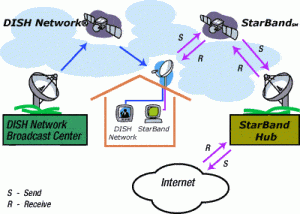Satellite Internet – Does Dish Have Internet?
How does satellite internet work?

Does dish have internet?
Satellite dishes transmit microwaves of internet data between the user’s access point, space, and a local hub. While the world’s major cities – from New York to Bangkok – take internet access for granted these days, plenty of remote places still can’t connect. For example, 10% of Americans don’t have broadband internet connection in the United States because broadband is simply unavailable where they live.
Satellite internet is the most comprehensive solution to this problem. Satellites in space orbit don’t have the same limitations as land-radio solutions like mobile broadband. As a result, you can install and use satellite internet anywhere: from oil rigs in the middle of the Atlantic to lonely huts high in the Himalayas.
Does Dish Have Internet? - Satellite Internet

Satellite internet providers, like Dishnet™, Excede™, and HughesNet™, use satellite dishes to transmit microwaves of internet data between the user’s access point, space, and a local hub on Earth. The entire journey is 45,000 miles and takes between 500 and 1500 milliseconds.
Simply put, when you get on your HughesNet™, Excede™, or Dishnet™ and request a website from your home or office, the satellite network sends the text command to a satellite in space, which in turn returns the request to a NOC on earth to retrieve the information from an earth-based server. The information, be it a video clip, a movie, or a simple website request, is re-transmitted to the satellite, which will then return the request to your PC, laptop, or smartphone.
Internet satellites are locked in geosynchronous orbit, which means they don’t move relative to the ground underneath them. Users then establish a permanent connection between their satellite dish and the nearest satellite. This connection minimizes interruptions in service.
How About Coverage Where You Live?
Excede™, Excede, the main competitor of Hughesnet, provides broadband service in the same markets as HughesNet.
Dishnet™, DISH’s satellite internet service, provides internet access to users anywhere in the United States with a clear view of the Southern sky (where Dishnet’s satellites orbit).
HughesNet™ provides satellite internet access to users in the United States, Brazil, Europe, and India. HughesNet’s broadband service is also available in any location with a clear view of the Southern sky in the United States.

The Upsides and Downsides of Satellite Service
Download speed: 5-15 Mbps
Upload speed: 1-2 Mbps
Lag: 500-1500 ms
With download speeds of between 5 and 15 Mbps, satellite internet can be a good option if you don't need high speeds; unfortunately, a lag time ranging from 500 to 1500 ms lag (up to 300 times more than cable) makes the internet feel a lot slower than it technically is. It can also inhibit video streaming and real-time gaming.
Most satellite providers use complicated data allowance systems that throttle daytime speeds to keep individuals from overloading the system. Get around the system by scheduling system updates and other significant downloads for late at night, when everyone is asleep and demand for the internet is low.
If satellite internet service isn't reliable or fast enough, you may want to consider other Wireless Internet Options with higher speeds and less lag time.
Use this Coverage Check or Call Evdo Depot USA at 1-866-439-6630 to find a better solution for your wireless internet.
